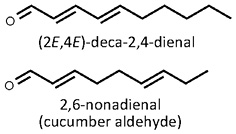 Borago officinalis
Borago officinalis
borage
Back to “Salad herbs and herb mixtures: borage (Borago officinalis)”
Back to “Culinary herbs: borage (Borago officinalis)”
Borago officinalis L. (Boraginaceae); komkommerkruid (Afrikaans); bourrache (French); Borretsch (German); boragine (Italian); borraja (Spanish)
DESCRIPTION Borage leaves and stems are covered in bristly hairs and the flowers are typically bright blue but may also be pink or rarely white. The taste and flavour of borage are similar to that of cucumber.
THE PLANT This is a robust, leafy annual with thick, soft stems bearing large leaves and clusters of drooping, star-shaped flowers.
ORIGIN The plant is believed to be of Middle Eastern origin but it occurs naturally in the western Mediterranean region and southern Europe.1 According to beliefs dating back to ancient Greece, borage gives courage and eliminates sadness. It has spread to most temperate regions of the world where it is often grown in herb gardens.
CULTIVATION Propagation is from seeds – borage may seed itself and can become somewhat weedy. Nowadays it is often grown more for decorative than culinary purposes. Large-scale production is aimed at producing seeds for the extraction of the valuable seed oil.
HARVESTING Leaves and flowers may be sporadically harvested throughout the season. Seeds are mechanically harvested for oil extraction.
CULINARY USES Freshly picked young leaves have a mild, cucumber-like taste and are traditionally used as a potherb and ingredient of salads, puréed soups and cucumber pickles. The characteristic taste is quickly lost when the leaves are cooked or boiled. Borage is still popular in Germany, Spain, France, northern Italy and Poland despite the fact that it contains trace amounts of poisonous alkaloids. In Germany, borage is one of the essential ingredients of the popular Frankfurt green sauce (Frankfurter Grüne Sauce) together with six other herbs (burnet, chervil, chives, cress, parsley and sorrel), vegetable oil, boiled egg yolks, vinegar and white pepper. The borage may be replaced with cucumber. Green sauce is typically served with meat, fish, vegetables or young potatoes. In Britain, borage leaves and flowers have traditionally been added to gin drinks and cocktails (such as Pimm’s No. 1, Pimm’s cup and claret cup). Nowadays, a sliver of cucumber peel is often used instead. The crystallized (candied) flowers are one of only a few food items with a blue colour and are a popular garnish on cakes, desserts and fruit salads.
FLAVOUR COMPOUNDS The main volatile compound responsible for the cucumber-like flavour of borage is (E,E)-2,4-decadienal.2 It is structurally closely related to 2,6-nonadienal (so-called “cucumber aldehyde”), the main aroma compound of cucumbers.3

NOTES Pyrrolizidine alkaloids occur in trace amounts in leaves and flowers,4 so that regular culinary use may not be entirely safe. The same is true for comfrey (Symphytum officinalis) formerly much used for making herbal tea. Borage seed oil (“starflower oil”) has become a popular functional food item and dietary supplement to alleviate the symptoms of eczema and stress-related ailments. It contains gamma-linoleic acid (GLA), an essential fatty acid.
1. Mabberley, D.J. 2008. Mabberley’s plant-book (3rd ed.). Cambridge University Press, Cambridge.
2. Mhamdi, B., Wannes, W.A., Dhiffi, W., Marzouk, B. 2009. Volatiles from leaves and flowers of borage (Borago officinalis L.). Journal of Essential Oil Research 21: 504–506.
3. Schieberle, P., Ofner, S., Grosch, W. 1990. Evaluation of potent odorants in cucumbers (Cucumis sativus) and muskmelons (Cucumis melo) by aroma extract dilution analysis. Journal of Food Science 55: 193–195.
4. Martina, H., Holger, J., Gerhard, S. 2002. Thesinine-4’-O-β-glucoside – the first glycosylated plant pyrrolizidine alkaloid from Borago officinalis. Phytochemistry 60: 399–402.